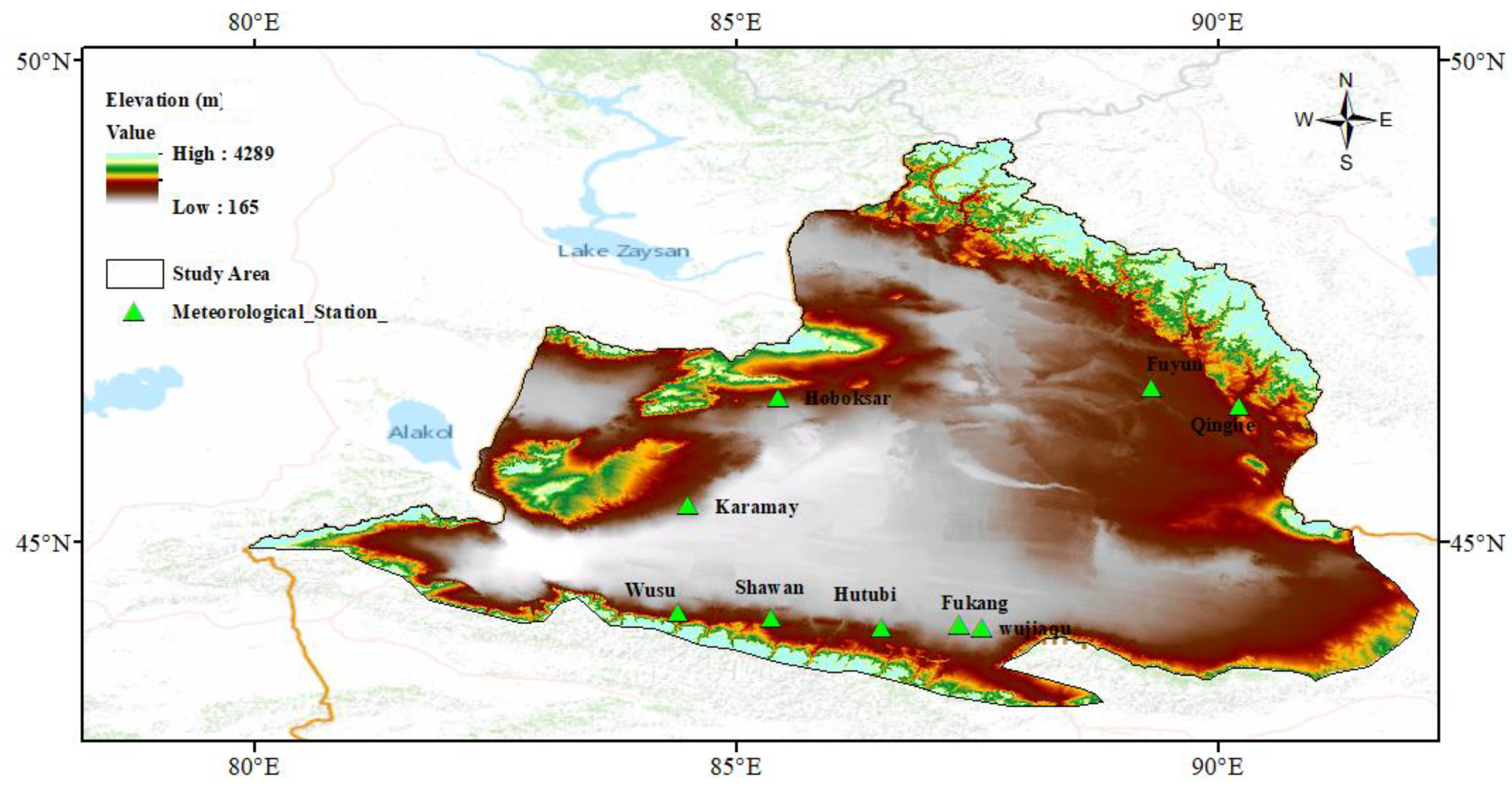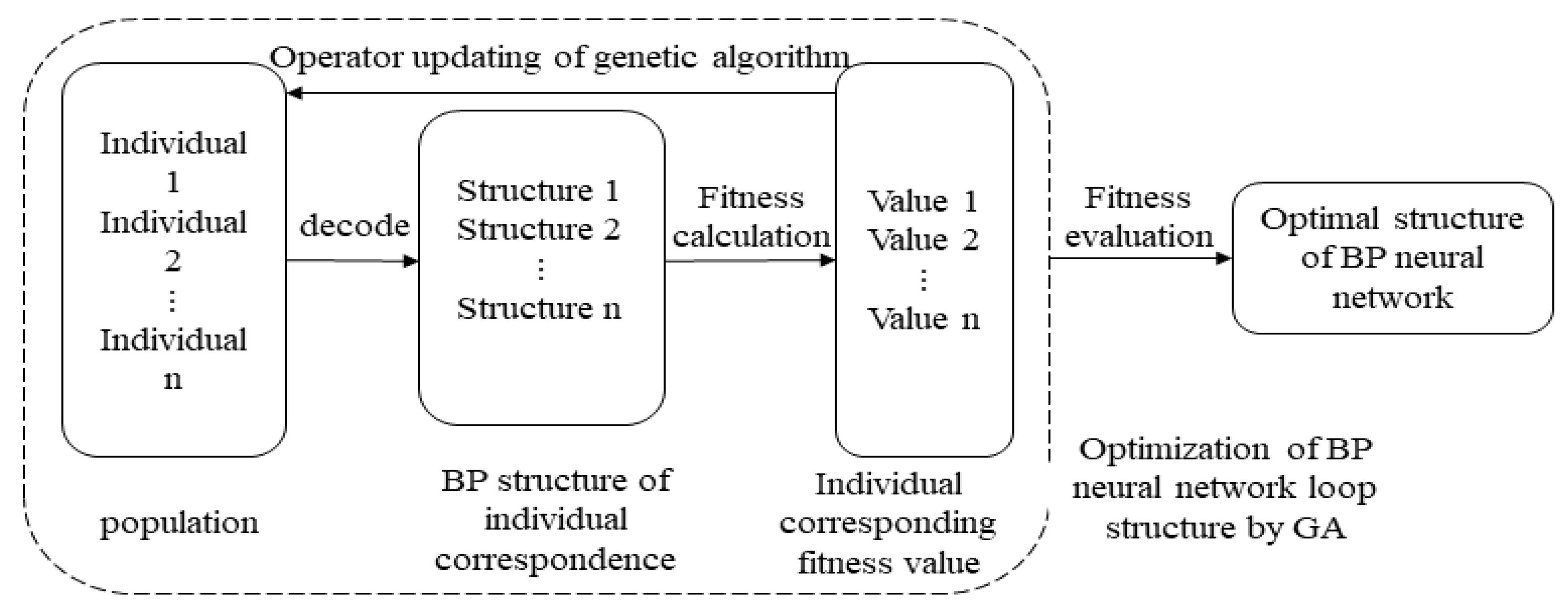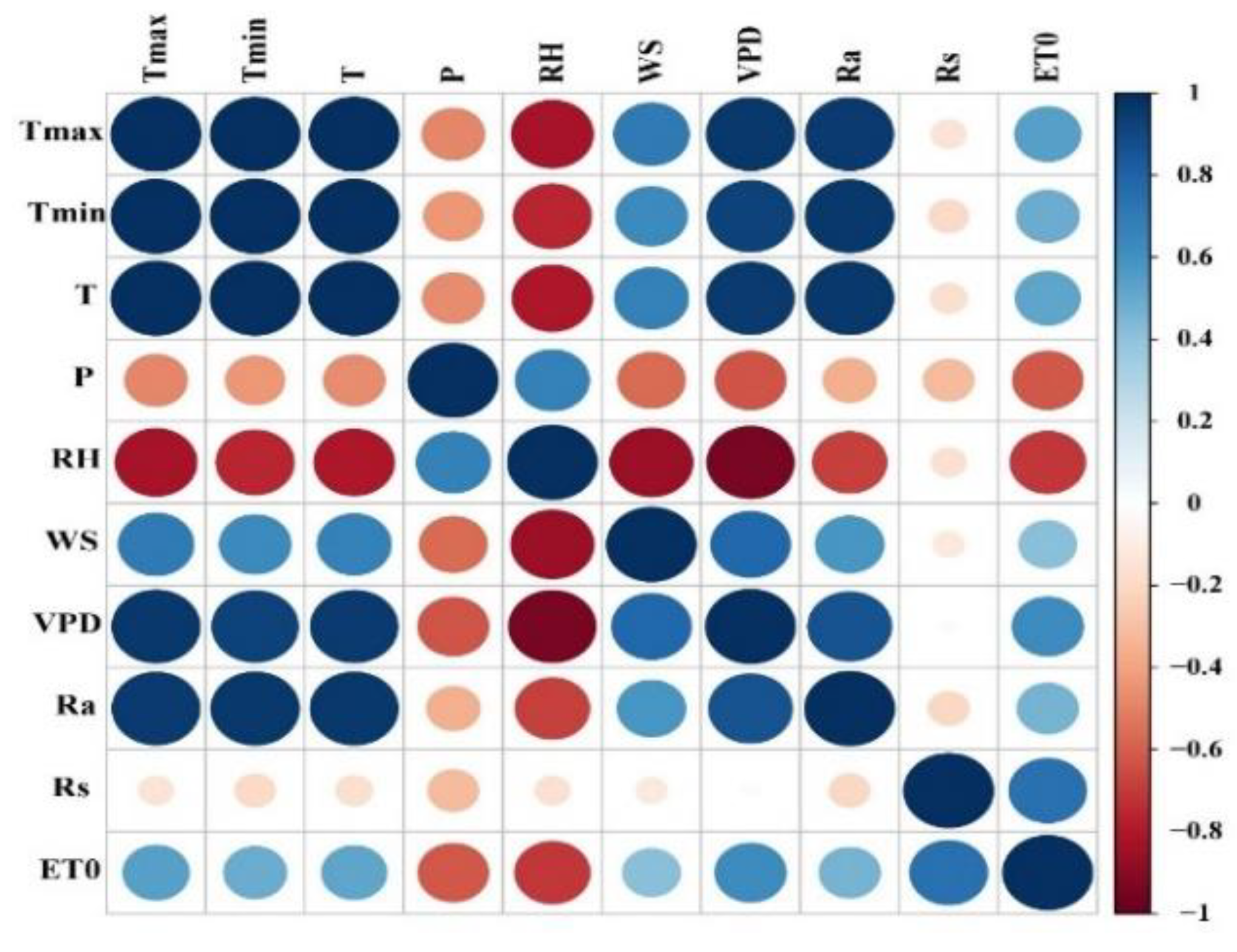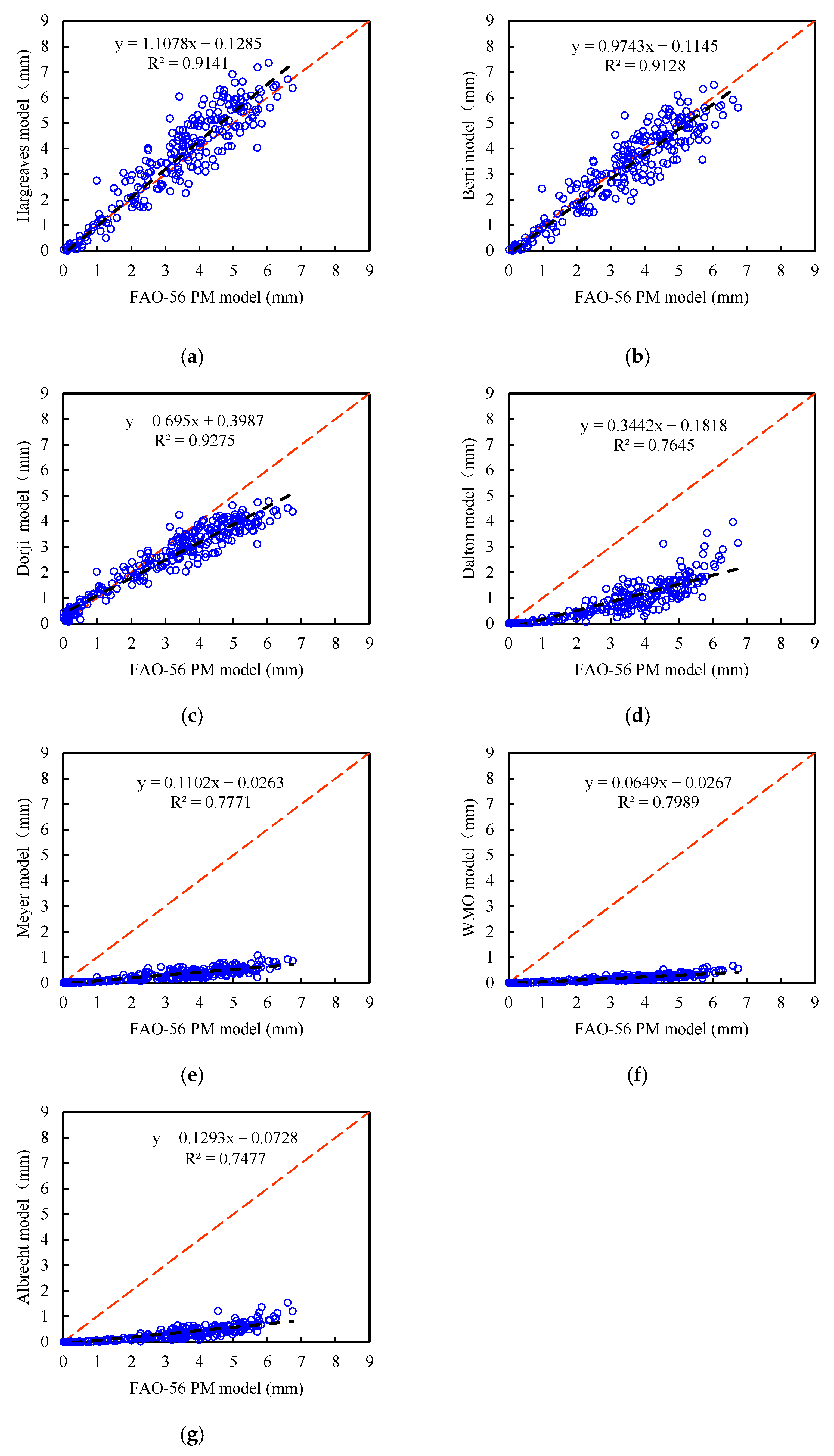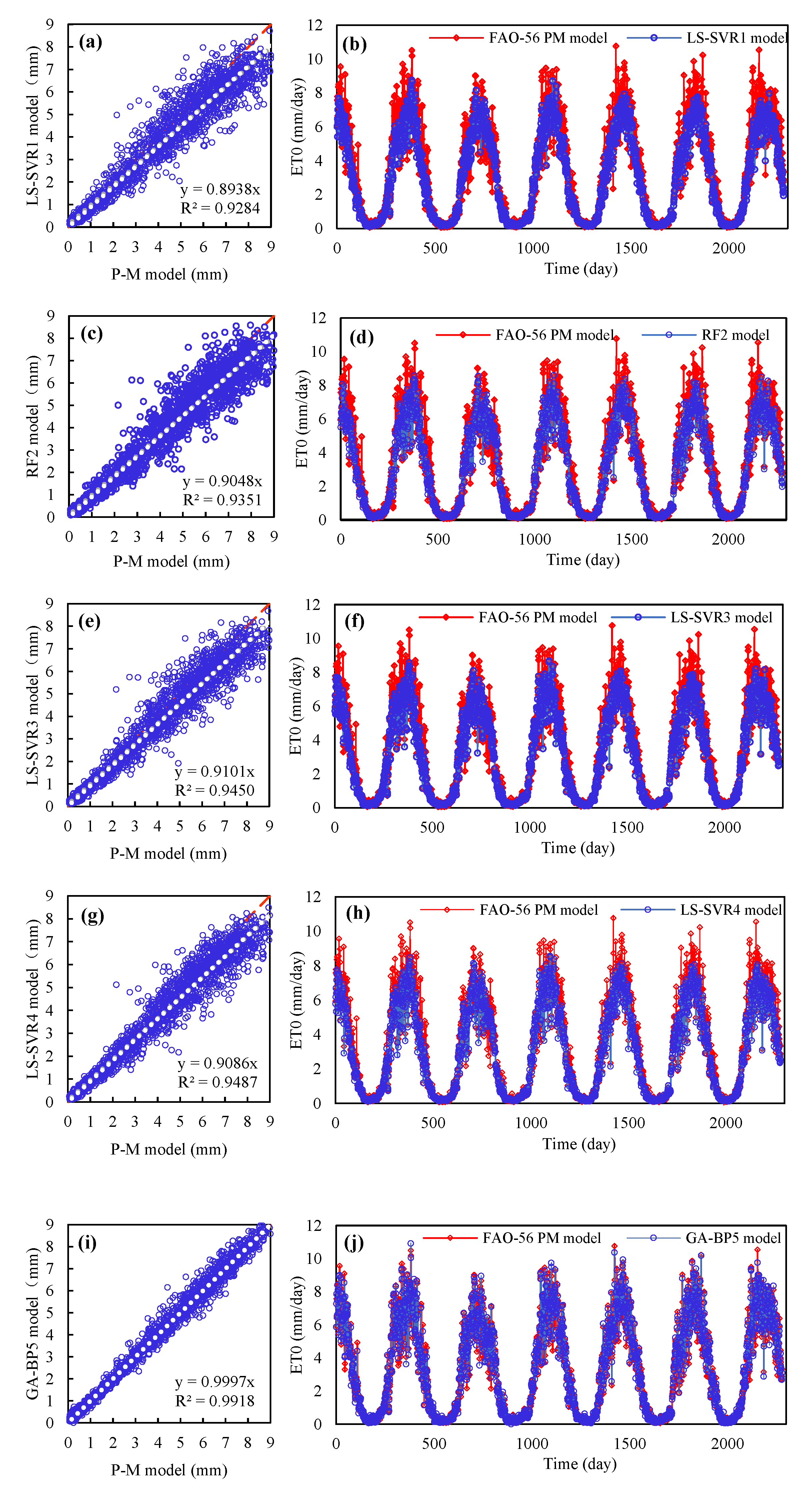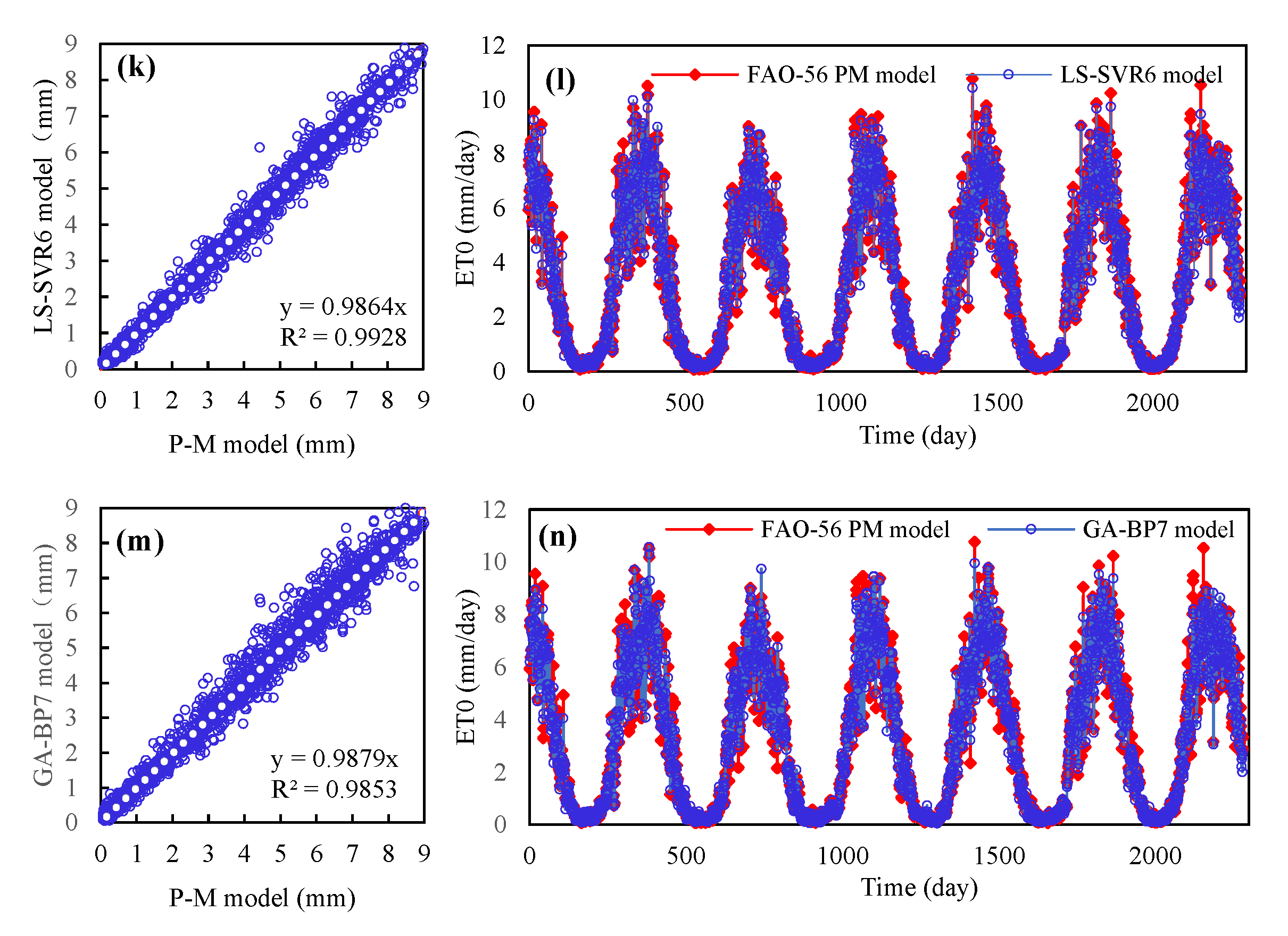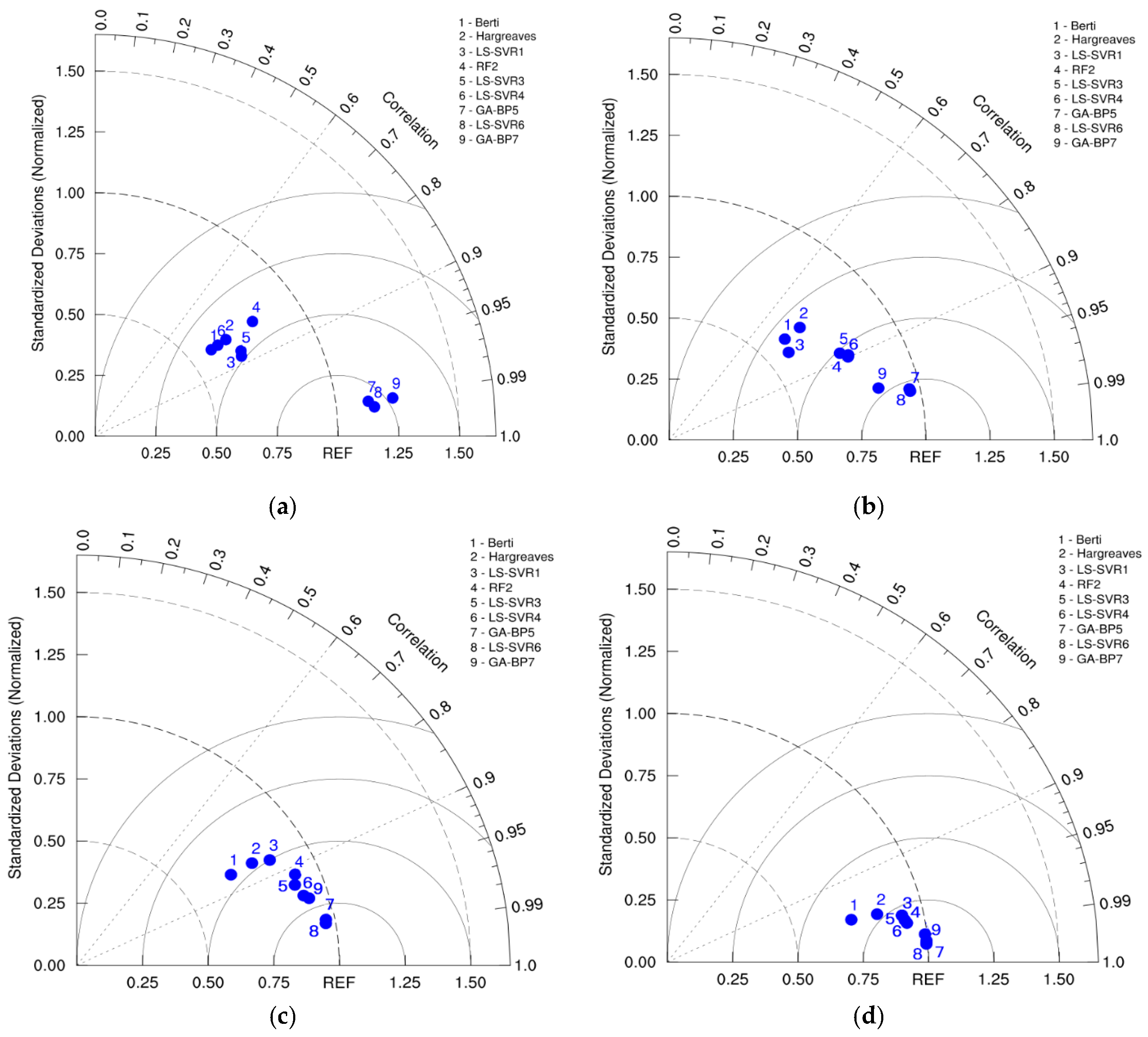1. Introduction
The quantification and accurate estimation of evapotranspiration are of great significance to the formulation of farmland irrigation systems, the study of hydrology and water balance, and the planning of water resources. The Penman Monteith (FAO56-PM) method recommended by the FAO [
1] is the standard method for estimating reference evapotranspiration (
ET0) thus far [
2,
3]. This method does not need to be initially calibrated locally and has global applicability [
4,
5,
6]. However, this method has many input parameters (air temperature, humidity, solar radiation and wind speed), so the acquisition of many meteorological parameters becomes the only limitation of its application [
7]. In this case, relatively simple empirical models are usually used to estimate
ET0, and the selection of the optimal empirical model is of great significance to water resource planning and management [
8,
9]. Existing empirical evapotranspiration models mainly include temperature-based, radiation-based, air-mass-transport-based and combination models. The results show that the combined models are better, followed by radiation-based, temperature-based and aerodynamic models [
10]. However, the combined model is highly dependent on the input of meteorological variables, which requires the sufficient input of meteorological variables, such as net radiation, soil heat flux, air temperature, wind speed and relative humidity. Moreover, some scholars also pointed out that, compared with the climate in humid and semi-humid regions,
ET0 in arid and semi-arid regions is mainly affected by aerodynamics and water vapor pressure deficit rather than radiation availability [
11,
12]. Therefore, the
ET0 model based on temperature and air mass transport was selected in this study to verify its applicability in northern Xinjiang.
In recent years, more scholars have applied artificial intelligence (AI) to the prediction and estimation of
ET0 and published a number of papers. For example, Vahid Nourani et al. [
13] used a feed-forward neural network (FFNN), adaptive neuro-fuzzy reasoning system (ANFIS), support vector machine regression (SVR) and other algorithms to simulate the
ET0 several climate zones of Turkey, Cyprus, Iraq, Iran and Libya. Ahmed Elbeltagi et al. [
14] estimated long-term
ET0 in Egypt through a deep neural network (DNN). Babak Mohammadi and Saeid Mehdizadeh [
15] used support vector regression (SVR) and random forest (RF) to simulate daily
ET0 from Isfahan, Urmiya and Yazd, Iran. Tongren Xu et al. [
16] evaluated the adaptability of machine learning, remote sensing and land surface
ET0 products in the United States. Saman Maroufpoor et al. [
17] simulated
ET0 in Iran by using artificial neural network optimization (ANN-GWO). Francesco Granata [
18] used the M5P regression tree, bagging, random forest (RF) and support vector machine regression (SVR) to simulate
ET0 in central Florida. Juan Yin et al. [
19] simulated
ET0 in the central Ningxia region of China by using the mixed bidirectional long- and short-term memory model (BI-LSTM). Jingran Liu et al. [
20] predicted the actual evapotranspiration of green pepper by using an extended neural network (MEA-ENN, GA-ENN) optimized by the mind evolutionary algorithm and genetic algorithm. The results show that artificial intelligence can accurately predict daily
ET0 and is a powerful tool for modelling
ET0 using incomplete meteorological parameters.
In summary, this study selected eight widely used empirical models for performance evaluation, including four temperature-based models: Hargreaves model [
21], Berti model [
22] and Dorji model [
23] and four mass transfer-based models: Dalton Model [
24], Meyer Model [
25], WMO Model [
26] and Albrecht Model [
27]. Four optimization algorithms (RF model, LS-SVR model, BI-LSTM model and GA-BP model) were combined with 28 optimization algorithm models to make a comprehensive ranking. On this basis, this study proposes the following hypotheses. First, the empirical model and the
ET0 model based on the optimization algorithm are significantly affected by time and space in northern Xinjiang. Second, simple linear regression and the global performance index GPI can effectively verify the performance effect of the
ET0 model in northern Xinjiang. The research objectives of this study are: (1) to use linear regression to verify seven empirical models to determine the best substitute for the FAO56-PM model in northern Xinjiang; (2) to use the global performance index GPI to rank the 28 models based on the optimization algorithm and to determine the best algorithm model under seven different parameter input combinations; and (3) to discuss the influence of time scale on the model and to recommend the most appropriate reference evapotranspiration estimation model for northern Xinjiang at different time scales. The innovation of this study lies in the first application of eight empirical models and four models based on an optimization algorithm in northern Xinjiang and the recommendation of corresponding models in the absence of meteorological data to fill the gap in knowledge regarding models suitable for northern Xinjiang under different meteorological parameters.
4. Results and Analysis
4.1. Performance Appraisal of Seven Empirical Models (Temperature-Based and Mass Transfer-Based) for Estimating ET0
Figure 5 shows that the three temperature-based empirical models have good applicability in northern Xinjiang, China, with
R2 values above 0.9. The Dorji model has the highest coefficient of determination, with
R2 up to 0.9275. However, the empirical model based on air mass transport is not ideal in northern Xinjiang, with an overall
R2 lower than 0.8, and the
R2 of the Albrecht model is only 0.7477. Compared with the 1:1 line, the Hargreaves model overestimate
ET0. The Berti model, Dorji model, Dalton model, Meyer model, WMO model and Albrecht model underestimated in northern Xinjiang. The average daily
ET0 of the Meyer model, WMO model and Albrecht model are all less than 2 mm, which is only 1/4 of that calculated by the P-M model, with a large error. Under the condition of wind speed
U2 and saturated vapour pressure difference (
es −
ea) as the only inputs, it is impossible to accurately estimate
ET0 in this region. Among the seven empirical models, the Berti model and Hargreaves model have the best calculation effect in the northern region of Xinjiang. However, the WMO model and Meyer model have poor simulation effects. This finding indicates that the model based on air mass transport has poor applicability in northern Xinjiang, which further proves that temperature is the decisive factor affecting
ET0 in northern Xinjiang.
4.2. Components Comparison of the Four Algorithm Models for Estimating ET0
In this study, seven different parameter combination input modes (
Table 3) and four optimization algorithms, including the RF, LS-SVR, Bi LSTM and GA-BP models, were used to rank and evaluate the models in the training period (
Table 4) and test period (
Table 5) by introducing the global performance index (
GPI). In the training period, the top 10% of the models were focused on the RF model, while the advantage of the RF model disappeared in the test period, which indicates that the RF model has overfitting in the training period, resulting in a significant reduction in the accuracy of the model in the test period. Therefore, the model evaluation in this paper is mainly based on the test period to reduce the impact of the overfitting algorithm on the simulation results.
Table 5 shows that the GA-BP5 model has the best overall simulation effect during the test period, with an
RMSE of 0.2542 mm·d
−1,
MAE of 0.1706 mm·d
−1,
MBE of −0.0039 and
R2 of 0.9918. The second best simulation is the LS-SVR6 model, wherein the
RMSE is 0.2380 mm·d
−1,
MAE is 0.1604 mm·d
−1,
MBE is −0.0425 and
R2 is 0.9928.
The worst model is the Bi-LSTM1 model, wherein the RMSE is 0.7811 mm·d−1, MAE is 0.5374 mm·d−1, MBE is −0.3776 and R2 is 0.9227. The worst Bi-LSTM1 model has the least number of input parameters, and the best, the GA-BP5 model and LS-SVR6 model, have the most input parameters, which shows that the number of input parameters has a great impact on the model simulation accuracy. In the same algorithm with different parameter combinations, the best results of RF model and LS-SVR model appear in the sixth group of parameter inputs (T, Tmax, Tmin, Ra, Rs and U2), and the best results of Bi LSTM model and GA-BP model appear in the fifth group of parameter inputs (T, Tmax, Tmin, Ra, Rs and U2); this finding shows that the accuracy of the model cannot be improved by 100% only by increasing the number of input parameters.
Because the influence of meteorological factors on reference evapotranspiration is different, considering RH and U2, RMSE decreases by 0.5 mm·d−1, MAE decreases by 0.32 mm·d−1, MBE amplitude decreases by 0.3 and R2 increases by 0.077. Considering the radiation terms Rs and U2 based on the temperature model, RMSE decreases by 0.52 mm·d−1, MAE decreases by 0.33 mm·d−1, MBE amplitude decreases by 0.28 and R2 increases by 0.076. The results show that the radiation term Rs and aerodynamic term U2 have a significant effect on reference evapotranspiration, and the reference evapotranspiration model is mainly composed of three parts: the temperature term, radiation term and aerodynamic term.
We obtained the optimal model results under different input combinations (
Table 6).
Figure 6 shows a comparison between the optimal model and the P-M model under the conditions of various input parameters, which can also support the view that the accuracy of simulation results is improved after considering the radiation term
Rs and aerodynamic term
U2 parameters.
4.3. Evaluation of Optimal Reference Evapotranspiration Model under Different Time-Scale Conditions
In the verification of the empirical model and optimization algorithm model, this paper takes the data from 2000 to 2020 as samples. A large amount of data and a long time span increase the model verification accuracy. Generally, the estimation of crop water requirements is only based on the reference crop evapotranspiration of 5–7 days. Therefore, the influence of different time scales on the simulation accuracy of the model is also included in the scope of this paper. We divided our data into four time scales, which were 7 days (1 July 2015 to 7 July 2015), one month (May 2019), one season (summer 2015) and one year (2017), and evaluated them with the Berti model, Hargreaves model and optimal model under seven different parameter input combinations.
Figure 7 shows a comparison of Taylor diagrams of models under different time scales. It can be seen from
Figure 7, when the time scale is 7 days, the range of standard deviation is 0.5~1.25, while, when the time scale is year, the range of standard deviation is reduced to 0.625~1, and the correlation is increased from 0.75 to 0.95. This result shows that the time scale has a significant effect on the accuracy of the model, and the accuracy of the model increases with increasing time scale. At the annual scale, the seven models based on the optimization algorithm are better. When meteorological data are missing, seven models can be used to estimate
ET0 in northern Xinjiang. Only the LS-SVR6 model and GA-BP7 model are recommended to estimate the local
ET0 at the daily, monthly and seasonal scales.
5. Discussion
The correlation between reference evapotranspiration model and meteorological factors is the key to determining the input parameters of the optimization model, and many studies have shown that air temperature is the primary factor affecting reference evapotranspiration [
4,
5,
7]. This study shows that
ET0 has a very significant positive correlation with the daily average temperature
T, the daily minimum air temperature
Tmin, the daily maximum air temperature
Tmax, the net radiation Ra and the saturated water vapor pressure difference
VPD at the level of
p < 0.001 (
Figure 3), and the saturated water air pressure difference
VPD is a function of temperature and humidity. The relative humidity
RH was negatively correlated with
ET0 at the level of
p < 0.001. The whole evapotranspiration process is dominated by temperature and net radiation
Ra. This result is consistent with the conclusions of some scholars [
22,
23,
24].
This study found that among the empirical models, the temperature-based model is more suitable for northern Xinjiang, this is consistent with the conclusion of Rachid et al. [
34]. That is, the temperature-based model is more suitable for arid and semi-arid areas. The reason is that heat is the main driving factor of water transmission and the key step of the water cycle, especially in arid and semi-arid areas with limited water resources. It is feasible and reliable to apply the optimization algorithm to
ET0 prediction. However, under the same parameter input conditions, the estimation accuracy of
ET0 at different scales is different, this conclusion is consistent with the views of some scholars [
35,
36,
37]. The main reason is that the time scale itself is the factor restricting the accuracy of the algorithm. It can be seen from
Figure 7 that the model based on the optimization algorithm is significantly better than the empirical, and this conclusion has also been verified in semi-arid areas of Spain [
38]. Chen et al. [
12] also pointed out that the model based on optimization algorithm is better than the empirical model, and the empirical model based on temperature factor is better than that based on radiation or humidity in the training and research area. It shows that the application of an optimization algorithm can greatly improve the estimation accuracy of the model and make up for the shortcomings of existing empirical formulas.
6. Conclusions
Based on the daily datasets of eight meteorological stations in northern Xinjiang, China, from 2000 to 2020, seven empirical models (Hargreaves, Berti, Dorji, Dalton, Meyer, WMO, and Albrecht) and 28 models based on optimization algorithms (RF, LS-SVR, Bi-LSTM and GA-BP) were compared. Through the evaluation of eight empirical models, the Berti model and Hargreaves model are better alternative models, while the WMO model and Meyer model are worse alternative models. The global performance index (GPI) is used to rank 28 models based on the optimization algorithm, and the optimal recommendation models of the annual scale and multi-year scale under different input parameter combinations are obtained as follows: LS-SVR1 (input: T, Tmax, Tmin, Ra), RF2 (input: T, Tmax, Tmin, Ra, Rs), LS-SVR3 (input: T, Tmax, Tmin, Ra, RH), LS-SVR4 (input: T, Tmax, Tmin, Ra, Rs, RH), GA-BP5 (input: T, Tmax, Tmin, Ra, RH, U2), LS-SVR6 (input: T, Tmax, Tmin, Ra, Rs, U2) and GA-BP7 (input: T, Tmax, Tmin, Ra, U2). Only the LS-SVR6 model and GA-BP7 model are recommended as the best alternative models for ET0 when the local climate dataset is incomplete at the daily, monthly and seasonal scales, which has high applicability in northern Xinjiang. This study can provide theoretical guidance and technical support for the determination of farmland irrigation systems and water resource planning and management in northern Xinjiang. This method is also applicable to other arid and semi-arid areas.
